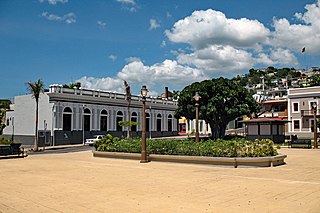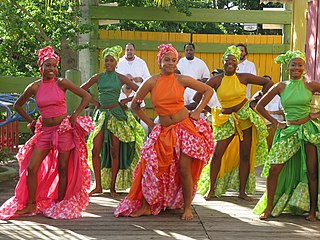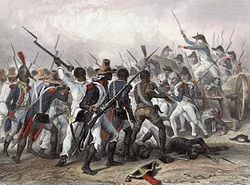
The population of Puerto Rico has been shaped by native American settlement, European colonization especially under the Spanish Empire, slavery and economic migration. Demographic features of the population of Puerto Rico include population density, ethnicity, education of the populace, health of the populace, economic status, religious affiliations and other aspects of the population.

Puerto Ricans, most commonly known as Boricuas, and also referred to as Borinqueños,Borincanos, or Puertorros, are the people of Puerto Rico, the inhabitants, and citizens of the Commonwealth of Puerto Rico and their descendants, including those in mainland United States.

Dominicans are an ethno-national people, a people of shared ancestry and culture, who have ancestral roots in the Dominican Republic. The Dominican ethnic group was born out of a fusion of European, native Taino, and African elements, which is an ethnic fusion that goes back to the 16th century. Due to this fusion, the majority of Dominicans are of mixed-race heritage, tracing roots mainly to these three sources with the vast majority being of predominant European ancestry. The demonym Dominican can be traced as far back as the 1621. The name came from Santo Domingo, which was not only the name of the capital city but also of the entire island at the time, Spain used this term to refer to the inhabitants of Spanish colony of Santo Domingo. Recent immigrants and their children, who are legal citizens of the Dominican Republic, can be considered "Dominican" by nationality but not ethnicity due to not having ancestral roots in the country.

Añasco, named after one of its settlers, Don Luis de Añasco, is a town and municipality of Puerto Rico located on the west coast of the island bordering the Mona Passage to the west, north of Mayagüez, and Las Marias; south of Rincón, Aguada, and Moca and west of San Sebastián and Las Marias. It is part of the Aguadilla-Isabela-San Sebastián Metropolitan Statistical Area.

Yauco is a town and municipality in southern Puerto Rico. Although the downtown is inland, the municipality stretches to a southern coast facing the Caribbean Sea. Yauco is located south of Maricao, Lares and Adjuntas; east of Sabana Grande and Guánica; and west of Guayanilla. The municipality consists of 20 barrios and Yauco Pueblo. It is both a principal town of the Yauco Metropolitan Statistical Area and the Ponce-Yauco-Coamo Combined Statistical Area.

Puerto Rican Spanish is the variety of the Spanish language as characteristically spoken in Puerto Rico and by millions of people of Puerto Rican descent living in the United States and elsewhere. It belongs to the group of Caribbean Spanish variants and, as such, is largely derived from Canarian Spanish and Andalusian Spanish. Outside of Puerto Rico, the Puerto Rican accent of Spanish is also commonly heard in the U.S. Virgin Islands and many U.S. mainland cities like Orlando, New York City, Philadelphia, Miami, Tampa, Boston, Cleveland, and Chicago, among others. However, not all stateside Puerto Ricans have knowledge of Spanish. Opposite to island-born Puerto Ricans who primarily speak Spanish, many stateside-born Puerto Ricans primarily speak English, although many stateside Puerto-Ricans are fluent in Spanish and English, and often alternate between the two languages.

Corsican immigration to Puerto Rico resulted in the 19th century from widespread economic and political changes in Europe that made life difficult for the peasant and agricultural classes in Corsica and other territories. The Second Industrial Revolution drew more people into urban areas for work, widespread crop failure resulted from long periods of drought, and crop diseases, and political discontent rose. In the early nineteenth century, Spain lost most of its possessions in the so-called "New World" as its colonies won independence. It feared rebellion in its last two Caribbean colonies: Puerto Rico and Cuba. The Spanish Crown had issued the Royal Decree of Graces of 1815 which fostered and encouraged the immigration of European Catholics, even if not of Spanish origin, to its Caribbean colonies.
Isleños are the descendants of Canarian settlers and immigrants to present-day Louisiana, Puerto Rico, Texas, Cuba, the Dominican Republic, Venezuela, and other parts of the Americas. In these places, the name isleño was applied to the Canary Islanders to distinguish them from Spanish mainlanders known as "peninsulars". Formerly used for the general category of people, it now refers to the specific cultural identity of Canary Islanders or their descendants throughout Latin America and in Louisiana, where they are still called isleños. Another name for Canary Islander in English is "Canarian." In Spanish, an alternative is canario or isleño canario.
German immigration to Puerto Rico began in the early part of the 19th century and continued to increase when German businessmen immigrated and established themselves with their families on the island.

French immigration to Puerto Rico came about as a result of the economic and political situations which occurred in various places such as Louisiana, Saint-Domingue (Haiti) and in Europe.

Afro–Puerto Ricans are Puerto Ricans who are of African descent. The history of Puerto Ricans of African descent begins with free African men, known as libertos, who accompanied the Spanish Conquistadors in the invasion of the island. The Spaniards enslaved the Taínos, many of whom died as a result of new infectious diseases and the Spaniards' oppressive colonization efforts. Spain's royal government needed laborers and began to rely on African slavery to staff their mining and fort-building operations. The Crown authorized importing enslaved West Africans. As a result, the majority of the African peoples who entered Puerto Rico were the result of the Atlantic slave trade, and came from many different cultures and peoples of the African continent.

Stateside Puerto Ricans, also ambiguously known as Puerto Rican Americans, or Puerto Ricans in the United States, are Puerto Ricans who are in the United States proper of the 50 states and the District of Columbia who were born in or trace any family ancestry to the unincorporated US territory of Puerto Rico.
Canary Islanders, or Canarians, are the people of the Canary Islands, an autonomous community of Spain near the coast of northwest Africa. The distinctive variety of the Spanish language spoken in the region is known as habla canaria or the (dialecto) canario. The Canarians, and their descendants, played a major role during the conquest, colonization, and eventual independence movements of various countries in Latin America. Their ethnic and cultural presence is most palpable in the countries of Uruguay, Venezuela, Cuba and the Dominican Republic as well as the U.S. territory of Puerto Rico.
Historically, Puerto Rico, which is now an unincorporated territory of the U.S., has been dominated by a settler society of religiously and ethnically diverse Europeans, primarily of Spanish descent, and Sub-Saharan Africans. The majority of Puerto Ricans are multi-ethnic, including people of European, African, Asian, Native American, and of mixed-ethnic descent.

Spanish immigration to Cuba began in 1492, when the Spanish first landed on the island, and continues to the present day. The first sighting of a Spanish boat approaching the island was on 27 October 1492, probably at Bariay on the eastern point of the island. Columbus, on his first voyage to the Americas, sailed south from what is now The Bahamas to explore the northeast coast of Cuba and the northern coast of Hispaniola. Columbus came to the island believing it to be a peninsula of the Asian mainland.

The Spanish diaspora consists of Spanish people and their descendants who emigrated from Spain. In the Americas, the term may refer to those of Spanish nationality living there; "Hispanic" is usually a more appropriate term to describe the general Spanish-speaking populations of the Americas together with those in Spain. The diaspora is concentrated in places that were part of the Spanish Empire. Countries with sizeable populations are Argentina, Bolivia, Chile, Colombia, Costa Rica, Cuba, Dominican Republic, Ecuador, El Salvador, Guatemala, Honduras, Mexico, Nicaragua, Panama, Paraguay, Peru, Uruguay, Venezuela, and, to a lesser extent, Brazil, Belize, Haiti, United States, Canada, the Philippines and the rest of Europe.

Large-scale Chinese immigration to Puerto Rico and the Caribbean began during the 19th century. Chinese immigrants had to face different obstacles that prohibited or restricted their entry in Puerto Rico.
Non-Hispanic cultural diversity in Puerto Rico and the basic foundation of Puerto Rican culture began with the mixture of the Spanish, Taíno and African cultures in the beginning of the 16th century. In the early 19th century, Puerto Rican culture became more diversified with the arrival of hundreds of families from non-Hispanic countries such as Corsica, France, Germany and Ireland. To a lesser extent other settlers came from Lebanon, China, Portugal and Scotland.

Spanish settlement of Puerto Rico began in the early 1500s shortly after the formation of the Spanish state in 1493 and continues to the present day.

Mixed Dominicans, also referred to as mulatto, mestizo or historically quadroon, are Dominicans who are of mixed racial ancestry. Representing 73.9% of the Dominican Republic's population, they are by far the single largest racial grouping of the country.




















